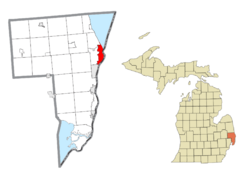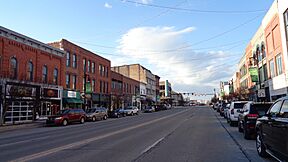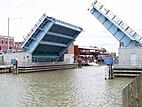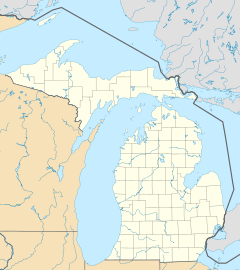Port Huron, Michigan facts for kids
Quick facts for kids
Port Huron, Michigan
|
|
|---|---|
| City of Port Huron | |
|
Images from top to bottom, left to right: Downtown along Huron Avenue, Blue Water Bridge, Fort Gratiot Light, Federal Building and U.S. Courthouse, Seventh Street–Black River Bridge
|
|
| Nickname(s):
Maritime Capital of the Great Lakes; Gateway to Canada
|
|

Location within St. Clair County
|
|
| Country | United States |
| State | Michigan |
| County | St. Clair |
| Settled | 1814 |
| Incorporated | 1849 (village) 1857 (city) |
| Government | |
| • Type | Council–manager |
| Area | |
| • Total | 12.27 sq mi (31.78 km2) |
| • Land | 8.10 sq mi (20.98 km2) |
| • Water | 4.17 sq mi (10.80 km2) |
| Elevation | 604 ft (184 m) |
| Population
(2020)
|
|
| • Total | 28,983 |
| • Density | 3,578.15/sq mi (1,381.53/km2) |
| Time zone | UTC−5 (Eastern (EST)) |
| • Summer (DST) | UTC−4 (EDT) |
| ZIP code(s) |
48060, 48061
|
| Area code(s) | 810 |
| FIPS code | 26-65820 |
| GNIS feature ID | 1624839 |
Port Huron is a city in Michigan, located in St. Clair County. It is the main city of the county. In 2020, about 28,983 people lived there. The city is next to Port Huron Township, but they are managed separately.
Port Huron is found where the St. Clair River starts, at the southern end of Lake Huron. The city is right on the border with Canada and across the river from Sarnia, Ontario. The two cities are connected by the Blue Water Bridge. This bridge is where two major highways, Interstate 69 and Interstate 94, end. Port Huron is the easternmost point of land in Michigan. It is also part of the larger Detroit metropolitan area.
Contents
History of Port Huron
The Ojibwa people lived in this area for a long time. French explorers and traders had a temporary fort and trading post here in the 1600s.
After the War of 1812, the United States built Fort Gratiot in 1814. A town grew around this fort. This was the first time a permanent European-American community was established here. In the 1800s, the U.S. set up an Ojibwa reservation in part of what is now Port Huron. However, in 1836, the U.S. government made the Ojibwa move west of the Mississippi River.
Port Huron officially became a city in 1857. Its population grew quickly after the 1850s. Many people came from Europe, looking for better lives. They were drawn to the successful shipbuilding and lumber industries in Michigan. By 1859, nearly half of the city's 4,031 residents were either foreign-born or their children.
By 1870, Port Huron was larger than nearby villages. In 1871, it was chosen as the main city for St. Clair County.
On October 8, 1871, a big fire, known as the Port Huron Fire of 1871, swept through the city. Other major fires happened on the same day in other parts of Michigan and nearby states. Another large fire, the Thumb Fire, also affected Port Huron ten years later.
In 1895, the village of Fort Gratiot joined the city of Port Huron.
Historic Places to Explore
Michigan has recognized several historic sites in Port Huron:
- Fort St. Joseph: This fort was built by French explorer Duluth in 1686. It was the second European settlement in lower Michigan. The French used it to guard the St. Clair River, which connects Lake Erie and Lake Huron. The fort was abandoned in 1688. Its site was later part of Fort Gratiot in 1814. Today, there is a park where the fort once stood.
- Fort Gratiot Lighthouse: This lighthouse was built in 1829. It replaced an older tower that was destroyed in a storm. In the 1860s, the tower was made taller, reaching 84 feet (26 m). The light helps guide ships on Lake Huron into the St. Clair River. It was the first lighthouse built in Michigan.
- Lightship Huron: From 1935 to 1970, the Huron was a special ship that marked dangerous shallow areas in Lake Huron. After 1940, it was the only lightship on the Great Lakes. The Coast Guard retired it in 1970, and it became a museum in Port Huron in 1971.
- Grand Trunk Railway Depot: This old train station is now part of the Port Huron Museum. It's famous because Thomas Edison, when he was 12, used to leave from here daily on the train to Detroit. In 1859, he started selling newspapers and candy on these trips. He was so good at it that he hired other boys to help him. He earned enough money to support himself and buy materials for his experiments.
- Port Huron Public Library: In 1902, the city received money from Andrew Carnegie to build a public library. A beautiful building was completed in 1904. Melvil Dewey, who created a famous book classification system, spoke at its opening. The library served the city for over 60 years. In 1967, a new, larger library was built. The old building became the Port Huron Museum of Arts and History.
- Harrington Hotel: This hotel opened in 1896. It has a mix of Romanesque, Classical, and Queen Anne styles. The hotel closed in 1986, but investors bought it to turn it into housing for senior citizens. The Harrington Hotel is listed on the National Register of Historic Places.
- Grand Trunk Western Railroad Tunnel: This tunnel opened in 1891 and connects Port Huron with Canada. It was the world's first international underwater railway tunnel. The tunnel is 6,025 feet (1,836 m) long, with 2,290 feet (698 m) underwater. It was electrified in 1908 and later switched to diesel fuel. During World War I, a plan to blow up the tunnel was stopped. A newer tunnel has since been built.
In May 1953, a strong tornado hit the city. It damaged or destroyed over 400 buildings, and two people died.
Port Huron has won the All-America City Award twice, in 1955 and 2005. This award recognizes cities for their community efforts.
In June 1962, a famous student meeting took place near Port Huron. The Students for a Democratic Society adopted the Port Huron Statement there. This important document helped shape the New Left movement. A historical marker was placed at the site in 2025.
In November 2017, veterans from across the country gathered in Port Huron to share the meaning of Veterans Day.
In April 2023, the Pere Marquette Railway bridge was taken down. This bridge, built in 1931, was one of only six similar bridges left in the U.S.
Geography and Climate
Port Huron covers about 12.26 square miles (31.75 km²). About 8.08 square miles (20.93 km²) is land, and 4.18 square miles (10.83 km²) is water. The city is part of the "Thumb" area of Michigan, also known as the "Blue Water Area." The easternmost point of land in Michigan is in Port Huron. The Black River flows through the city and into the St. Clair River near downtown.
Weather in Port Huron
Port Huron has a climate with hot summers and cold winters. It gets rain or snow throughout the year.
| Climate data for Port Huron NOAA Station (1991–2020 normals, extremes 1931–present) | |||||||||||||
|---|---|---|---|---|---|---|---|---|---|---|---|---|---|
| Month | Jan | Feb | Mar | Apr | May | Jun | Jul | Aug | Sep | Oct | Nov | Dec | Year |
| Record high °F (°C) | 64 (18) |
69 (21) |
82 (28) |
87 (31) |
96 (36) |
102 (39) |
103 (39) |
102 (39) |
101 (38) |
90 (32) |
81 (27) |
66 (19) |
103 (39) |
| Mean maximum °F (°C) | 51.0 (10.6) |
51.7 (10.9) |
65.1 (18.4) |
77.0 (25.0) |
86.7 (30.4) |
92.0 (33.3) |
93.5 (34.2) |
91.8 (33.2) |
88.7 (31.5) |
79.0 (26.1) |
64.4 (18.0) |
54.0 (12.2) |
95.3 (35.2) |
| Mean daily maximum °F (°C) | 30.9 (−0.6) |
33.3 (0.7) |
42.2 (5.7) |
54.2 (12.3) |
66.7 (19.3) |
76.4 (24.7) |
81.3 (27.4) |
79.7 (26.5) |
73.1 (22.8) |
60.5 (15.8) |
46.9 (8.3) |
36.0 (2.2) |
56.8 (13.8) |
| Daily mean °F (°C) | 25.4 (−3.7) |
26.9 (−2.8) |
35.2 (1.8) |
46.1 (7.8) |
57.7 (14.3) |
67.6 (19.8) |
73.3 (22.9) |
71.8 (22.1) |
65.0 (18.3) |
53.2 (11.8) |
41.0 (5.0) |
31.2 (−0.4) |
49.5 (9.7) |
| Mean daily minimum °F (°C) | 19.9 (−6.7) |
20.5 (−6.4) |
28.3 (−2.1) |
38.0 (3.3) |
48.8 (9.3) |
58.8 (14.9) |
65.2 (18.4) |
64.0 (17.8) |
56.8 (13.8) |
46.0 (7.8) |
35.2 (1.8) |
26.4 (−3.1) |
42.3 (5.7) |
| Mean minimum °F (°C) | 1.1 (−17.2) |
2.8 (−16.2) |
10.8 (−11.8) |
24.4 (−4.2) |
36.2 (2.3) |
46.0 (7.8) |
54.3 (12.4) |
53.3 (11.8) |
42.2 (5.7) |
32.5 (0.3) |
20.2 (−6.6) |
9.7 (−12.4) |
−2.5 (−19.2) |
| Record low °F (°C) | −19 (−28) |
−15 (−26) |
−7 (−22) |
8 (−13) |
21 (−6) |
32 (0) |
35 (2) |
37 (3) |
25 (−4) |
20 (−7) |
2 (−17) |
−7 (−22) |
−19 (−28) |
| Average precipitation inches (mm) | 2.48 (63) |
2.06 (52) |
2.21 (56) |
3.15 (80) |
3.53 (90) |
3.62 (92) |
3.25 (83) |
3.14 (80) |
3.32 (84) |
3.13 (80) |
2.81 (71) |
2.17 (55) |
34.87 (886) |
| Average snowfall inches (cm) | 11.1 (28) |
11.4 (29) |
4.6 (12) |
0.4 (1.0) |
0.0 (0.0) |
0.0 (0.0) |
0.0 (0.0) |
0.0 (0.0) |
0.0 (0.0) |
0.0 (0.0) |
1.3 (3.3) |
6.7 (17) |
35.5 (90) |
| Average precipitation days (≥ 0.01 in) | 14.0 | 10.3 | 10.8 | 12.9 | 13.0 | 10.9 | 10.1 | 10.3 | 10.1 | 12.6 | 11.8 | 12.7 | 139.5 |
| Average snowy days (≥ 0.1 in) | 7.4 | 5.9 | 2.9 | 0.6 | 0.0 | 0.0 | 0.0 | 0.0 | 0.0 | 0.0 | 0.8 | 4.4 | 22.0 |
| Source: NOAA | |||||||||||||
Population and People
| Historical population | |||
|---|---|---|---|
| Census | Pop. | %± | |
| 1850 | 1,584 | — | |
| 1860 | 4,371 | 175.9% | |
| 1870 | 5,973 | 36.7% | |
| 1880 | 8,883 | 48.7% | |
| 1890 | 13,543 | 52.5% | |
| 1900 | 19,158 | 41.5% | |
| 1910 | 18,863 | −1.5% | |
| 1920 | 25,944 | 37.5% | |
| 1930 | 31,361 | 20.9% | |
| 1940 | 32,759 | 4.5% | |
| 1950 | 35,725 | 9.1% | |
| 1960 | 36,084 | 1.0% | |
| 1970 | 35,794 | −0.8% | |
| 1980 | 33,981 | −5.1% | |
| 1990 | 33,694 | −0.8% | |
| 2000 | 32,338 | −4.0% | |
| 2010 | 30,184 | −6.7% | |
| 2020 | 28,983 | −4.0% | |
| U.S. Decennial Census | |||
Port Huron is the largest city in the "Thumb" area of Michigan. It is a hub for business and trade in the region.
In 2010, there were 30,184 people living in Port Huron. About 84% of the people were White, 9.1% were African American, and 5.4% were Hispanic or Latino. About 25.6% of residents were under 18 years old.
Culture and Fun
- The Port Huron Museum has four different museums:
- Carnegie Center
- Huron Lightship
- Thomas Edison Depot Museum
- Fort Gratiot Lighthouse
- The Great Lakes Maritime Center teaches visitors about the history of the Great Lakes. You can watch large freighters pass by and even see an underwater camera feed.
- The Desmond District Demons is a horror film festival held every October. It shows independent horror films and art by local artists.
- The Black River Film Society hosts independent film screenings and events. They have shown movies like Stockholm and Tough Guy: The Bob Probert Story.
- The School for Strings puts on over 50 concerts each year. They offer music education in the area.
- Every year, the Port Huron to Mackinac Boat Race starts in Port Huron and ends at Mackinac Island. Boats race across Lake Huron.
- The Port Huron Civic Theatre started in 1956. Since 1983, they have performed their plays at McMorran Place.
- The main branch of the St. Clair County Library is in downtown Port Huron. It has many books, magazines, and audio materials.
- The International Symphony Orchestra, from Sarnia, Ontario, and Port Huron, Michigan, performs at McMorran Place and other venues.
- The Olde Town Historic District has over 100 historic homes and buildings. The Olde Town Historic Neighborhood Association works to protect these old buildings. They host home tours and help beautify the neighborhood.
- The Welkin Base Ball Club is Port Huron's historic vintage base ball team. They play baseball using rules from 1867, showing how the game used to be.
Port Huron in Pop Culture
The movie The Big Lebowski mentions the Port Huron Statement.
In 2009, the TV show Criminal Minds used Port Huron and Detroit as settings for an episode.
Sports and Recreation
Port Huron has a long history of minor league hockey.
The Port Huron Flags played in the International Hockey League from 1962 to 1981. They won three championships. Famous hockey broadcaster Mike Emrick started his career doing play-by-play for the Flags in the 1970s.
Later, other hockey teams like the Border Cats, Beacons, Flags, and Icehawks played in Port Huron. The Port Huron Fighting Falcons played junior hockey from 2010 to 2013.
Today, the Port Huron Prowlers play in the Federal Prospects Hockey League.
Port Huron also had indoor football teams, including the Port Huron Pirates and the Port Huron Predators.
Parks and Outdoor Fun
The City of Port Huron has 17 waterfront areas, covering 102 acres (0.41 km²) and 3.5 miles (5.6 km) of water frontage. This includes three public beaches and six parks with picnic areas. There are also nine scenic spots with parking. Port Huron has the largest city-run marina system in Michigan, with five places for boats to dock.
The city has 14 public parks, 4 smaller "tot" parks, and 19 playgrounds owned by the city. There are also 33 tennis courts, 4 public swimming pools, and a community center.
City Government
Port Huron's government is run by a city council and a city manager. The City Council chooses the city manager, who is in charge of the city's daily operations. The manager makes sure city departments run smoothly and follows the council's decisions.
The City Council has seven elected officials: a mayor and six council members. Council members serve four-year terms, and the mayor serves a two-year term. The city collects an income tax from residents and non-residents.
The current mayor is Anita Ashford. She was elected in November 2024.
Port Huron is part of Michigan's 64th State House District and is represented by Joseph G. Pavlov. In the State Senate, Port Huron is represented by Dan Lauwers.
For the U.S. Congress, Port Huron is in Michigan's 9th Congressional District. It is represented by Lisa McClain, who was elected in 2022.
Backyard Chickens in Port Huron
In early 2025, people in Port Huron started working to make it legal to keep backyard chickens. They pointed out that some families in Port Huron struggle to get enough healthy food. Allowing chickens could provide a steady source of eggs and help neighbors share food.
On March 10, 2025, the Port Huron City Council talked about a plan to let residents keep up to five hens on properties that are at least a quarter-acre. Supporters said this would help with food independence and is done in other Michigan cities. The plan included rules for noise and animal care, like not allowing roosters.
The new rule was officially introduced on April 14, 2025, and the City Council voted 6–1 to approve it. The rules say hens must be kept in a coop in the backyard, with enough space for each bird. The coop must be at least ten feet from property lines and twenty feet from neighbors' homes. Hens must be fed and watered daily, and coops must be cleaned regularly to prevent pests. Hens are not allowed inside homes or garages.
These changes in Port Huron show a growing interest in urban farming and self-sufficiency across Michigan.
Education
High Schools
- Port Huron Northern High School
- Port Huron High School
- Harrison Center
Colleges
- St. Clair County Community College
Economy and Jobs
Industries in Port Huron
Some of Port Huron's first industries were linked to farming. There was a large grain elevator and a "bean dock" where dry beans were loaded onto ships. Port Huron was also a leader in making chicory, a coffee substitute. Henry McMorran started a chicory processing plant in 1902. Chicory was often used as a coffee substitute, especially during wartime.
During World War I, the Mueller Metals Company built a factory in Port Huron in 1917. This plant mainly made shell casings for the war. The factory is still open today, making valves and fittings.
The Peerless Cement Company operated a cement plant from the 1920s to the 1970s. This waterfront site is now home to the Edison Inn and the Blue Water Convention Center.
Port Huron also had two paper mills. Dunn Paper operated a special paper mill, and Domtar had another paper mill. The Domtar mill, built in 1888, made specialty papers for medical and food industries. The Domtar Mill closed in 2021, and the Dunn Paper Mill closed in 2022. However, in 2025, it was announced that the former Domtar Mill would reopen under new ownership as Legacy Paper Group.
Many factories related to the automotive industry are in Port Huron's Industrial Park. They often make plastic parts for cars.
Shipbuilding History
The Jenks Shipbuilding Company started in 1889. It was later called Port Huron Shipbuilding and stopped operating after 1908. The shipyard was on the Black River, where there is now a parking area and kayak launch.
Some ships built by Jenks include:
- SS Henry Steinbrenner (1901) - a large freighter lost in a storm on Lake Superior.
- SS John B. Cowle (1902) - another large freighter.
- MS Normac (1902) - a former fireboat that became a floating restaurant.
- SS Eastland (1902) - a passenger ship that tragically capsized in Chicago.
Healthcare Services
Port Huron has two main hospitals: McLaren Port Huron and Lake Huron Medical Center.
McLaren Port Huron is a 186-bed hospital. It was bought by McLaren Health Care Corporation in May 2014.
Lake Huron Medical Center is a 144-bed hospital. It was bought by Prime Healthcare Services in September 2015.
Transportation
Major Roads
Two major highways end at the Blue Water Bridge, connecting Port Huron to Sarnia, Ontario:
 I-69 comes from Lansing and Flint and ends at the bridge. In Canada, it becomes Highway 402.
I-69 comes from Lansing and Flint and ends at the bridge. In Canada, it becomes Highway 402. I-94 comes from the Detroit area and also ends at the bridge. In Canada, it also becomes Highway 402.
I-94 comes from the Detroit area and also ends at the bridge. In Canada, it also becomes Highway 402. M-25 follows the Lake Huron shoreline.
M-25 follows the Lake Huron shoreline. M-29 starts just south of the city.
M-29 starts just south of the city.- M-136 runs west from M-25.
Public Transportation
The Blue Water Area Transit system started in 1976. It has eight bus routes in the Port Huron area. They also run the Blue Water Trolley, which gives a one-hour tour of local sights. Blue Water Area Transit recently got money to buy new buses for a route between Port Huron and New Baltimore, about 30 miles (48 km) south. This new system helps people travel to the Detroit area.
Train Services
- Amtrak offers passenger train service on the Blue Water route, connecting Chicago to Port Huron (Amtrak station).
- Two large freight railroads, Canadian National Railway (CN) and CSX Transportation (CSXT), operate in Port Huron. They use the St. Clair Tunnel for international connections.
- Via Rail offers train service from Toronto to Sarnia. However, this train does not cross the river, so passengers need to find other ways to get to Port Huron.
Airports
St. Clair County International Airport is a public airport located about five miles (8 km) southwest of downtown Port Huron.
Notable People from Port Huron
- Edward Goodrich Acheson (1856–1931), inventor of carborundum
- Jack Campbell, hockey player
- Thomas Edison (1847–1931), famous inventor, moved to Port Huron in 1854
- Jim Gosger, baseball player
- Herbert W. Kalmbach, attorney for President Richard Nixon
- Terry McMillan, author
- Henry McMorran, businessman and congressman
- Colleen Moore, silent movie actress
- Jason Motte, baseball pitcher
- Frank Secory, baseball player and umpire
- John Swainson (1925–1994), former Governor of Michigan
- Harold Sines Vance, businessman and government official
- Harry Wismer, broadcaster and sports team owner
Images for kids
See also
 In Spanish: Port Huron para niños
In Spanish: Port Huron para niños
Nearby Communities
 |
Fort Gratiot Township | Lake Huron | St. Clair River / |
 |
| Port Huron Township | St. Clair River / |
|||
| Marysville | St. Clair River | St. Clair River / |

















